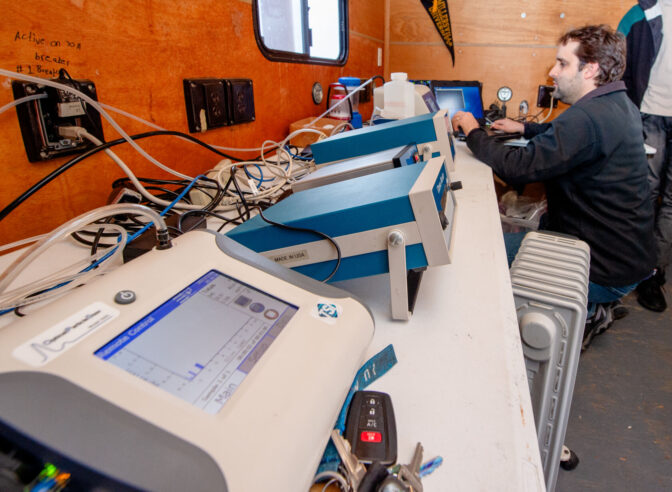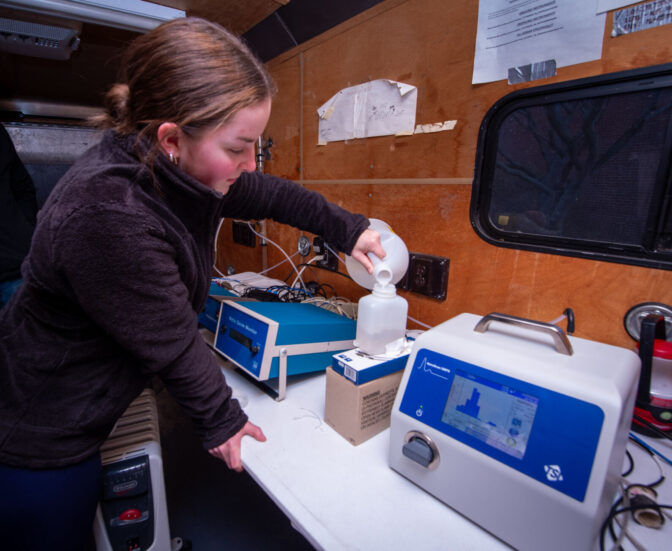The junction of routes 30 and 283 in Lancaster County now hosts more than daily commuters – it’s the site of an ongoing air quality study by Millersville University researchers to quantify how much pollution residents breathe in each day.
The study aims to heighten public awareness of the health risks airborne pollutants pose and to provide better local data that can be used as a baseline to assess how much trends such as changing weather patterns, development or a rise in electric vehicle use might affect air quality in the future.
The MU monitoring station sits near the spot where the county’s two busiest highways come together. According to data from the state Department of Transportation, an average of nearly 140,000 vehicles pass by each day.
Researchers started air quality measurements on Oct. 31, in time to gather a month of data before finals hit.
READ NEXT: Traffic safety measures questioned in Lancaster city’s southeast [Lancaster Watchdog]
Data collection will continue into the spring semester, when the team aims to publish a summary of its results on the MU website to provide the public with data analysis and context on the health implications of the pollutants they studied: particulate matter, black carbon and biomass, ozone and nitrogen oxides.
“It’s kind of like: how bad can it get? Especially given this area and the characteristics of this area,” said Greg Blumberg, the MU assistant professor of meteorology who is organizing the student research team.

Blaine Shahan / LNP | LancasterOnline
Greg Blumberg, assistant professor of meteorology at Millersville University, checks data collection inside the Air Quality Monitoring Station for Millersville Atmospheric Research and Aerostat Facility on Monday, Dec. 4, 2023. The monitoring station is a trailer, and is parked behind the Farm & Home Center 1383 Arcadia Road to monitor air quality from Rt. 30 which runs behind the Farm & Home Center.
Blumberg said the Lancaster County terrain creates a basin in which pollutants collect and accumulate with few opportunities for dispersal.
The American Lung Association’s 2023 “State of the Air” report gave Lancaster County an “F” for short-term particle pollution, naming it among the top 25 worst in the nation for the frequency of spikes in soot levels.
The addition of the MU monitoring station could help provide greater context, as the state Department of Environmental Protection has questioned whether localized pollution near one of the county’s monitoring stations has skewed the county’s overall results.
Measuring traffic’s impact
Thanksgiving week proved a good illustration of how traffic impacts pollution.
Nitrogen oxides, produced in fuel combustion, are gases that cause harm to respiratory systems. “Even very small amounts can have big effects on the human body,” Blumberg said.
Particulate matter consists of aerosols like soot, dust, pollen, or smoke. The MU instruments measure the mass of particulates (in micrograms) that exist in a volume (meters cubed). Particles 10 micrometers or smaller can enter the nose or lungs, while particles 2.5 micrometers or smaller can enter the bloodstream.
View this post on Instagram
Pollution readings on Thanksgiving of around 20 parts per billion (ppb) for nitrogen oxides and particulate matter around 4 micrograms per meters cubed (µg/m3) were rather low and likely the result of people staying at home, Blumberg reported.
However, the heavy travel days of Monday and Wednesday before Thanksgiving showed some of the highest peaks of nitrogen oxides concentration since the study began, with 110 ppb on Monday morning and 95 ppb on Wednesday morning.
In contrast, Black Friday readings proved not very different from a normal work week. The team expected traffic to nearby shopping centers would generate higher pollution concentrations, but the measurements showed nitrogen oxides between 20-50 ppb and particulate matter between 5-15 µg/m3.
“This result might be because people are doing more online than in-person shopping on Black Friday,” Blumberg said.
See below for a graphic representation of the results. Weather data is included to help interpret changes in pollution levels. Warmer temperatures tend to increase pollution, while rainfall acts to clean the air, Blumberg explained.
Millersville Traffic Emissions Charts by Liz DeOrnellas on Scribd
Building on life experience
Blumberg started at MU in August 2022 and previously worked at the NASA Goddard Space Flight Center in Greenbelt, Maryland. He is partnering with two student researchers.
Keelie Steiner is in her third year of undergraduate meteorology studies at MU. She plans to graduate in the spring and continue her studies with the goal of earning a doctorate in atmospheric chemistry.
After growing up an hour north of Pittsburgh in Sharpsville, Mercer County, Steiner said MU’s unique mix of farmland and city development intrigued her.
“I was very used to just cornfields and cow pastures,” Steiner said. “So, coming out here, it’s really interesting to see that combination of rural and urban life.”

Blaine Shahan / LNP | LancasterOnline
Keelie Steiner, a Millersville University undergraduate student, pours isopropyl alcohol into a scanning mobility particle sizer inside the Air Quality Monitoring Station for Millersville Atmospheric Research and Aerostat Facility on Monday, Dec. 4, 2023. The monitoring station is a trailer that’s parked behind the Farm & Home Center 1383 Arcadia Road to monitor air quality from Rt. 30 which runs behind the Farm & Home Center.
Steiner feels personally connected to the work of monitoring air quality. Her sister was born with severe asthma and both her parents are medical professionals.
Fellow student researcher Emmanuel Owusu also draws on medical experience. He is an optometrist from Ghana who is in his first year at MU, working toward a master’s degree in integrated scientific application. Owusu wants to pursue a doctorate in environmental and occupational health sciences.
Owusu’s work treating eye disease has brought an expanded focus to the team’s research. He said much of the discussion around the risks of poor air quality centers on respiratory or cardiovascular illness, but airborne pollutants can also exacerbate conditions such as glaucoma or cataracts.
The two semesters worth of air quality data the team will have in hand by spring is just a starting point. Steiner said she doesn’t expect a single year of monitoring to produce any immediate public policy implications.
“There’s just not enough data to march into Harrisburg,” Steiner said.
However, Blumberg aims to keep the project going for years, and Steiner said she looks forward to future generations of students gaining field experience and generating a bank of data points deep enough to illustrate changing conditions and inform forecasts.


0 Commentaires